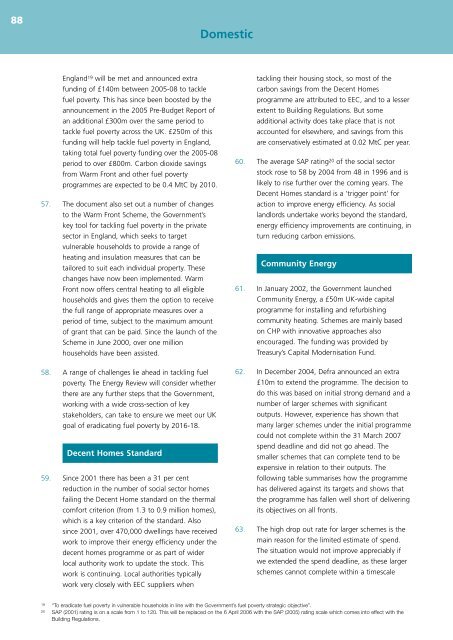UK Climate Change Programme 2006 - JNCC - Defra
UK Climate Change Programme 2006 - JNCC - Defra
UK Climate Change Programme 2006 - JNCC - Defra
You also want an ePaper? Increase the reach of your titles
YUMPU automatically turns print PDFs into web optimized ePapers that Google loves.
88<br />
Domestic<br />
England 19 will be met and announced extra<br />
funding of £140m between 2005-08 to tackle<br />
fuel poverty. This has since been boosted by the<br />
announcement in the 2005 Pre-Budget Report of<br />
an additional £300m over the same period to<br />
tackle fuel poverty across the <strong>UK</strong>. £250m of this<br />
funding will help tackle fuel poverty in England,<br />
taking total fuel poverty funding over the 2005-08<br />
period to over £800m. Carbon dioxide savings<br />
from Warm Front and other fuel poverty<br />
programmes are expected to be 0.4 MtC by 2010.<br />
57. The document also set out a number of changes<br />
to the Warm Front Scheme, the Government’s<br />
key tool for tackling fuel poverty in the private<br />
sector in England, which seeks to target<br />
vulnerable households to provide a range of<br />
heating and insulation measures that can be<br />
tailored to suit each individual property. These<br />
changes have now been implemented. Warm<br />
Front now offers central heating to all eligible<br />
households and gives them the option to receive<br />
the full range of appropriate measures over a<br />
period of time, subject to the maximum amount<br />
of grant that can be paid. Since the launch of the<br />
Scheme in June 2000, over one million<br />
households have been assisted.<br />
58. A range of challenges lie ahead in tackling fuel<br />
poverty. The Energy Review will consider whether<br />
there are any further steps that the Government,<br />
working with a wide cross-section of key<br />
stakeholders, can take to ensure we meet our <strong>UK</strong><br />
goal of eradicating fuel poverty by 2016-18.<br />
Decent Homes Standard<br />
59. Since 2001 there has been a 31 per cent<br />
reduction in the number of social sector homes<br />
failing the Decent Home standard on the thermal<br />
comfort criterion (from 1.3 to 0.9 million homes),<br />
which is a key criterion of the standard. Also<br />
since 2001, over 470,000 dwellings have received<br />
work to improve their energy efficiency under the<br />
decent homes programme or as part of wider<br />
local authority work to update the stock. This<br />
work is continuing. Local authorities typically<br />
work very closely with EEC suppliers when<br />
tackling their housing stock, so most of the<br />
carbon savings from the Decent Homes<br />
programme are attributed to EEC, and to a lesser<br />
extent to Building Regulations. But some<br />
additional activity does take place that is not<br />
accounted for elsewhere, and savings from this<br />
are conservatively estimated at 0.02 MtC per year.<br />
60. The average SAP rating 20 of the social sector<br />
stock rose to 58 by 2004 from 48 in 1996 and is<br />
likely to rise further over the coming years. The<br />
Decent Homes standard is a ‘trigger point’ for<br />
action to improve energy efficiency. As social<br />
landlords undertake works beyond the standard,<br />
energy efficiency improvements are continuing, in<br />
turn reducing carbon emissions.<br />
Community Energy<br />
61. In January 2002, the Government launched<br />
Community Energy, a £50m <strong>UK</strong>-wide capital<br />
programme for installing and refurbishing<br />
community heating. Schemes are mainly based<br />
on CHP with innovative approaches also<br />
encouraged. The funding was provided by<br />
Treasury’s Capital Modernisation Fund.<br />
62. In December 2004, <strong>Defra</strong> announced an extra<br />
£10m to extend the programme. The decision to<br />
do this was based on initial strong demand and a<br />
number of larger schemes with significant<br />
outputs. However, experience has shown that<br />
many larger schemes under the initial programme<br />
could not complete within the 31 March 2007<br />
spend deadline and did not go ahead. The<br />
smaller schemes that can complete tend to be<br />
expensive in relation to their outputs. The<br />
following table summarises how the programme<br />
has delivered against its targets and shows that<br />
the programme has fallen well short of delivering<br />
its objectives on all fronts.<br />
63. The high drop out rate for larger schemes is the<br />
main reason for the limited estimate of spend.<br />
The situation would not improve appreciably if<br />
we extended the spend deadline, as these larger<br />
schemes cannot complete within a timescale<br />
19 “To eradicate fuel poverty in vulnerable households in line with the Government’s fuel poverty strategic objective”.<br />
20 SAP (2001) rating is on a scale from 1 to 120. This will be replaced on the 6 April <strong>2006</strong> with the SAP (2005) rating scale which comes into effect with the<br />
Building Regulations.
















